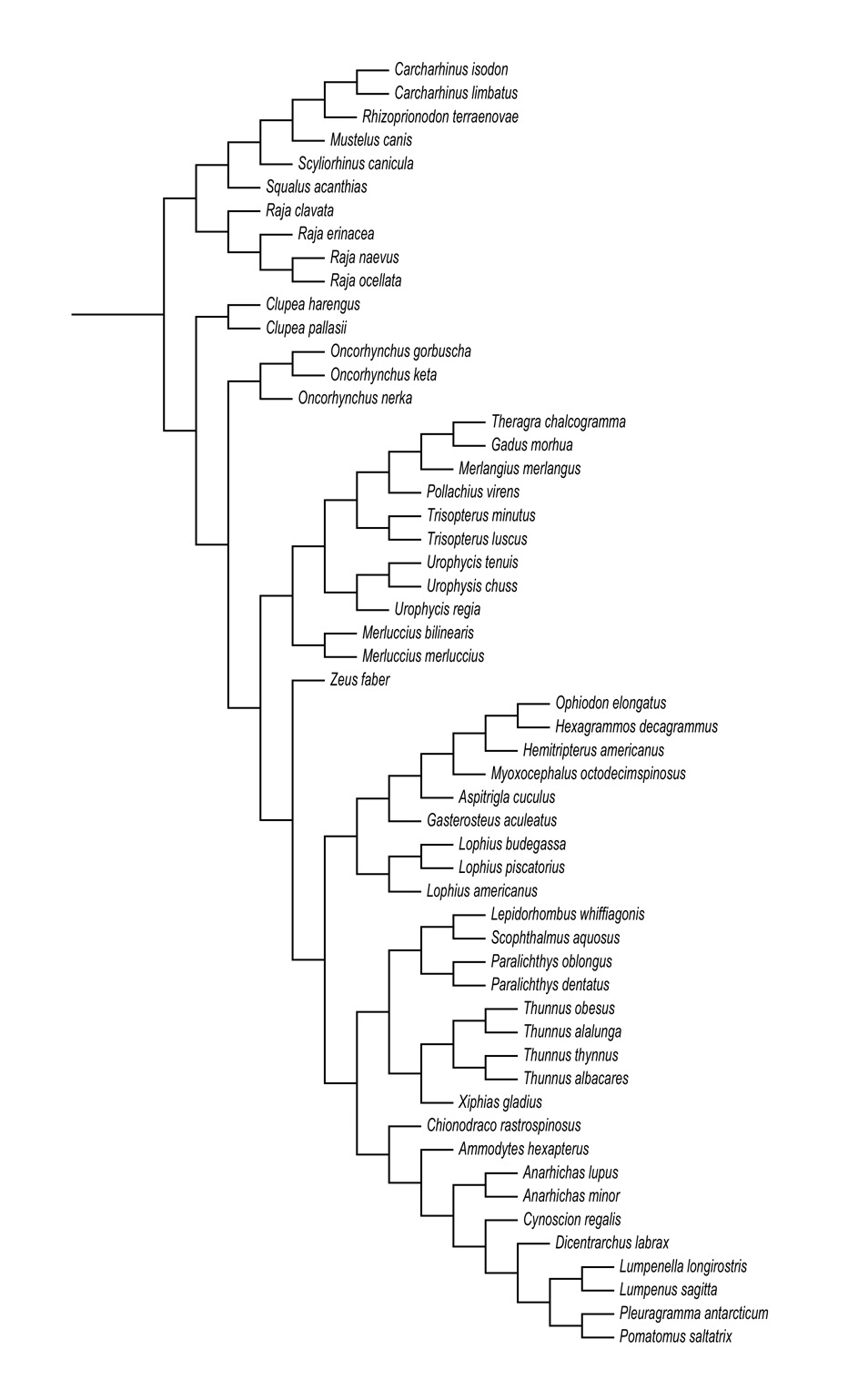Ecological Archives E090-139-A2
Gabriel C. Costa. 2009. Predator size, prey size, and dietary niche breadth relationships
in marine predators. Ecology 90:2014–2019.
Appendix B. Phylogenetic relationships of the species used in the analysis.

|
| |
FIG. B1. Phylogenetic relationships of the 55 marine predators used
in the analysis. Because there is not a comprehensive phylogeny containing all
species, we combine results from several different published phylogenies to
build our tree topology. Deepest lineages splitting was inferred based on the
tree of life webproject (http://tolweb.org/tree), whereas more recent groups
relationships were inferred based on several different published phylogenies
(Valsecchi et al. 2005, Chow et al. 2006, Lopez et al. 2006, Teletchea et al.
2006, Esteve and McLennan 2007, Li et al. 2007, Mabuchi et al. 2007).
Note: Relationships among some taxa are controversial and
different studies may point to slightly different topologies. In addition, for
some groups such as Perciformes, relationships among orders and within families
are not well supported. I ran the analyses using a more conservative approach
creating polytomies for these less supported groups and the results where very
similar with only minor changes in regression coefficients and slope values.
Given that the analyses using species as independent data points, and using
different phylogenetic hypotheses all converge to similar results, it is not
likely that changes in the topology will result in change in the major patterns
found. |
LITERATURE CITED
Chow, S., T. Nakagawa, N. Suzuki, H. Takeyama, and T.
Matsunaga. 2006. Phylogenetic relationships among Thunnus species inferred from
rDNA ITS1 sequence. Journal of Fish Biology 68:24–35.
Esteve, M., and D. A. McLennan. 2007. The phylogeny of
Oncorhynchus (Euteleostei : Salmonidae) based on behavioral and life history
characters. Copeia:520–533.
Li, C. H., G. Orti, G. Zhang, and G. Q. Lu. 2007. A
practical approach to phylogenomics: the phylogeny of ray-finned fish
(Actinopterygii) as a case study. BMC Evolutionary Biology 7:44.
Lopez, J. A., J. A. Ryburn, O. Fedrigo, and G. J. P. Naylor.
2006. Phylogeny of sharks of the family Triakidae (Carcharhiniformes) and its
implications for the evolution of carcharhiniform placental viviparity.
Molecular Phylogenetics and Evolution 40:50–60.
Mabuchi, K., M. Miya, Y. Azuma, and M. Nishida. 2007.
Independent evolution of the specialized pharyngeal jaw apparatus in cichlid
and labrid fishes. BMC Evolutionary Biology 7:10.
Teletchea, F., V. Laudet, and C. Hanni. 2006. Phylogeny of
the Gadidae (sensu Svetovidov, 1948) based on their morphology and two
mitochondrial genes. Molecular Phylogenetics and Evolution 38:189–199.
Valsecchi, E., P. Pasolini, M. Bertozzi, F. Garoia, N.
Ungaro, M. Vacchi, B. Sabelli, and F. Tinti. 2005. Rapid Miocene-Pliocene
dispersal and evolution of Mediterranean rajid fauna as inferred by
mitochondrial gene variation. Journal of Evolutionary Biology 18:436–446.
[Back to E090-139]
